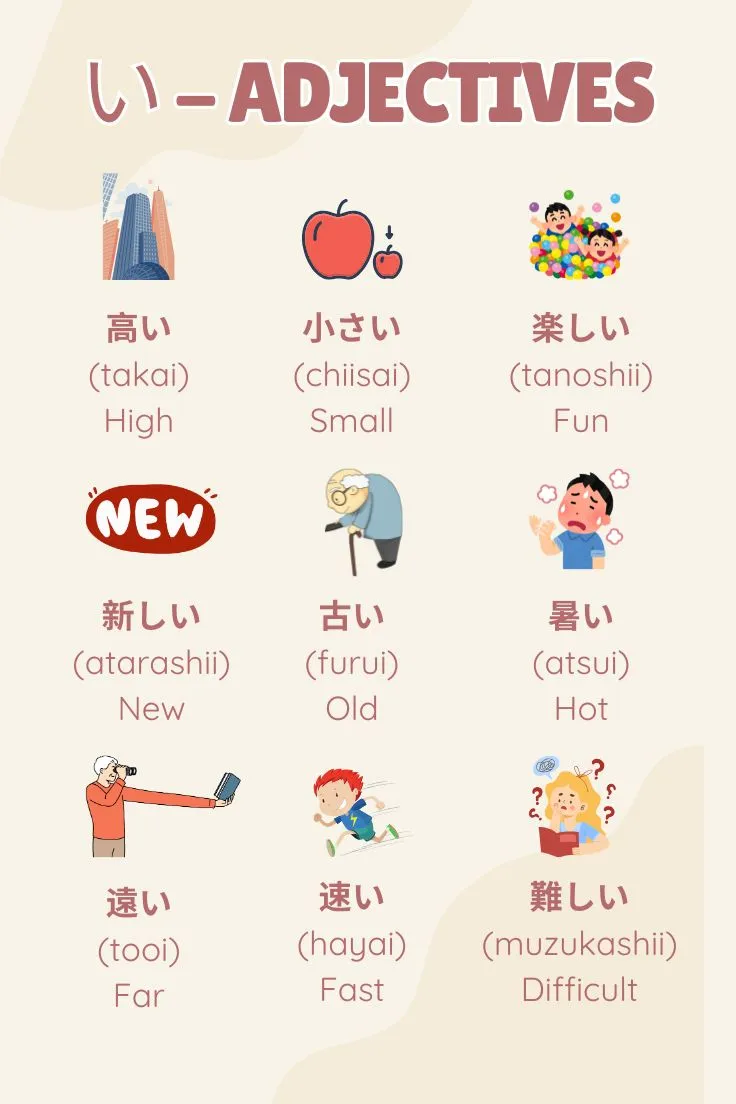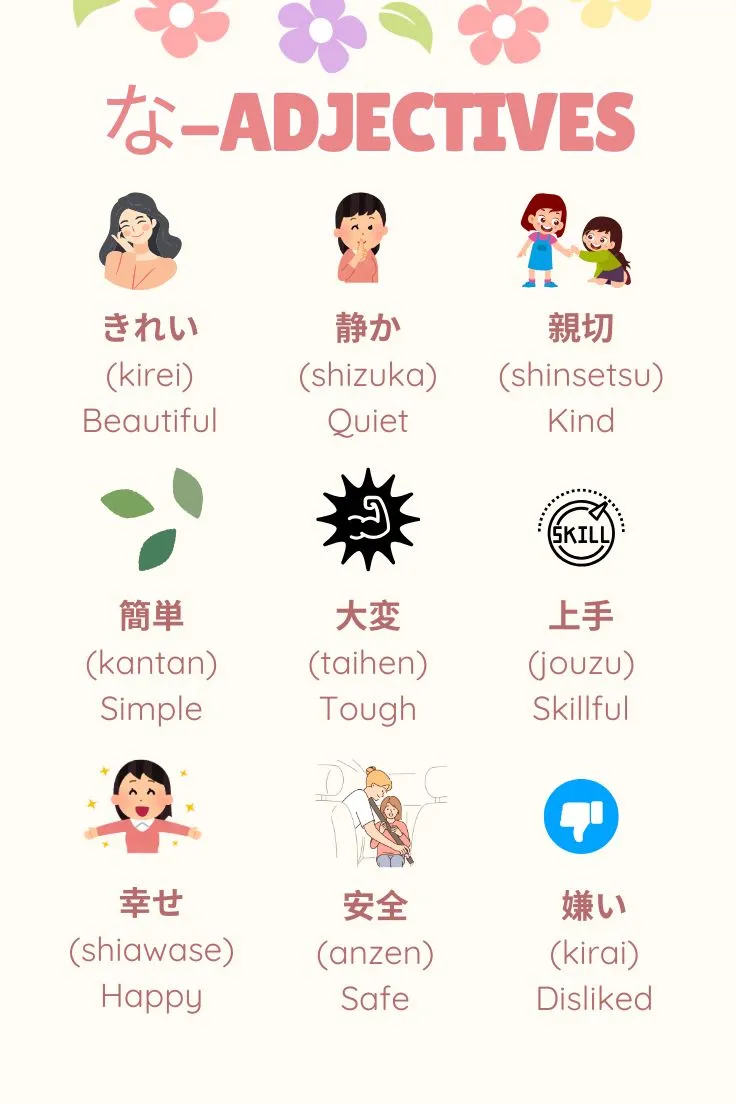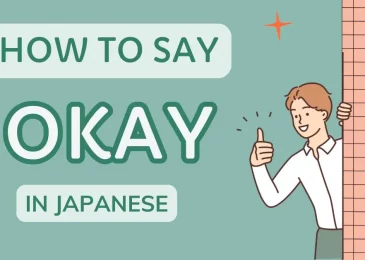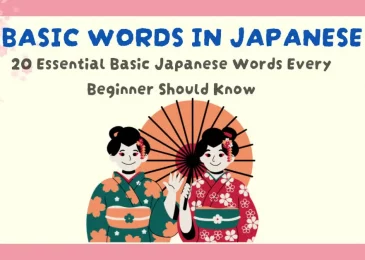If you’re learning Japanese, understanding adjectives is essential for describing everything from your favorite foods to your mood. Adjectives in Japanese are unique compared to English adjectives, but once you grasp their structure, they’re a great tool for enriching your conversations. This guide will take you through everything you need to know about adjectives in Japanese, including their types, usage, and common examples.
Types of adjectives in Japanese
In Japanese, adjectives fall into two main categories: い-adjectives (i-adjectives) and な-adjectives (na-adjectives). Each has its own set of rules for conjugation and usage. Let’s explore them in detail.
1. い-Adjectives (i-adjectives)
い-Adjectives are adjectives that end with the character 「い」. They are highly versatile because they can conjugate to indicate different tenses and levels of politeness. Common い-adjectives include:
- 楽しい (tanoshii) – fun
- 大きい (ookii) – big
- 新しい (atarashii) – new
These adjectives can also be used to describe states or actions directly, which makes them extremely flexible. Here’s an example of how they’re used:
- この映画は楽しいです (Kono eiga wa tanoshii desu) – This movie is fun.
To make an い-adjective negative or to change its tense, you simply modify the ending. For example:
- 楽しくない (tanoshikunai) – not fun
- 楽しかった (tanoshikatta) – was fun
- 楽しくなかった (tanoshikunakatta) – was not fun
2. な-Adjectives (na-adjectives)
な-Adjectives do not end in 「い」, though some may appear similar at first. These adjectives require the particle 「な」 when modifying nouns directly. Common な-adjectives include:
- きれい (kirei) – beautiful/clean
- 静か (shizuka) – quiet
- 便利 (benri) – convenient
Example sentence:
- この場所は静かです (Kono basho wa shizuka desu) – This place is quiet.
When modifying nouns directly, な-adjectives need the 「な」 particle. For example:
- 静かな場所 (shizuka na basho) – a quiet place
- 便利なツール (benri na tsuuru) – a convenient tool
Unlike い-adjectives, な-adjectives have simpler conjugation rules. For negative or past forms, you conjugate the auxiliary verb です (desu), not the adjective itself.
Understanding the role of adjectives in Japanese sentences
Adjectives in Japanese are versatile, serving more than just the purpose of description. They can act as noun modifiers, indicate states of being, and convey negative or past forms. Let’s dive into each of these functions in detail:
1. Modifying nouns directly
In Japanese, adjectives are frequently placed before nouns to describe their characteristics directly. This usage is very similar to English, where adjectives come before the noun (e.g., “a big house”). In Japanese, this is straightforward but requires attention to whether you’re using an い-adjective or a な-adjective, as they each have different rules.
- い-Adjectives: These adjectives directly modify the noun without any extra particle. For example:
- 大きい家 (ookii ie) – a big house
- 新しい車 (atarashii kuruma) – a new car
- な-Adjectives: When using a な-adjective to describe a noun, the particle な must be inserted between the adjective and the noun. For example:
- 静かな場所 (shizuka na basho) – a quiet place
- 便利なツール (benri na tsuuru) – a convenient tool
By directly modifying nouns, adjectives provide important details that help paint a fuller picture of the subject or object in the sentence.
2. Describing states
Adjectives in Japanese also act as stand-alone predicates to describe the current state or condition of a noun. This role is particularly common in casual conversation and allows adjectives to convey meaning without additional verbs.
- Using い-Adjectives as Predicates: An い-adjective can stand alone with a noun or pronoun to describe a current state. For example:
- 彼は元気です (Kare wa genki desu) – He is healthy.
- その本は面白いです (Sono hon wa omoshiroi desu) – That book is interesting.
- Using な-Adjectives as Predicates: Similarly, な-adjectives can be used as predicates, but they need the addition of です (desu) for polite speech. For example:
- 彼女はきれいです (Kanojo wa kirei desu) – She is beautiful.
- この場所は安全です (Kono basho wa anzen desu) – This place is safe.
In these examples, adjectives play a role much like verbs do in English, describing what or how something is. This usage is very useful for discussing qualities and states without adding extra complexity to the sentence.
3. Creating negative and past tenses
Japanese adjectives can also be conjugated to express negative or past forms, adding nuance to descriptions. This ability to conjugate adjectives is unique to Japanese and requires careful attention to the type of adjective you’re using.
- い-Adjectives
For い-adjectives, the last 「い」 is removed and replaced to indicate tense and polarity.
- Present Negative: Remove the final 「い」 and add くない.
- 古い (furui) – old → 古くない (furukunai) – not old
- Past Positive: Remove the final 「い」 and add かった.
- 楽しい (tanoshii) – fun → 楽しかった (tanoshikatta) – was fun
- Past Negative: Remove the final 「い」 and add くなかった.
- 楽しくない (tanoshikunai) – not fun → 楽しくなかった (tanoshikunakatta) – was not fun
- な-Adjectives
For な-adjectives, the conjugation occurs with です or だ (in more casual forms), rather than within the adjective itself.
- Present Negative: Add じゃないです (janai desu) for polite speech.
- 元気 (genki) – healthy → 元気じゃないです (genki janai desu) – not healthy
- Past Positive: Add でした (deshita).
- 便利 (benri) – convenient → 便利でした (benri deshita) – was convenient
- Past Negative: Add じゃなかったです (janakatta desu).
- 静か (shizuka) – quiet → 静かじゃなかったです (shizuka janakatta desu) – was not quiet
By changing forms, you can easily express a range of meanings such as time (past/present) and positivity/negativity, all within a single adjective. This flexibility makes adjectives a powerful tool for communicating detailed information concisely.
Common Adjectives in Japanese and How to Use Them
Below are some of the most frequently used adjectives in Japanese, divided by い-adjectives and な-adjectives. Use this list to expand your vocabulary and practice forming sentences with these essential descriptive words.
い-Adjectives (i-Adjectives)
| Japanese | Romaji | English Meaning | Example Sentence | Meaning |
|---|---|---|---|---|
| 高い | takai | high, expensive | この本は高いです。(Kono hon wa takai desu.) | This book is expensive. |
| 小さい | chiisai | small | その犬は小さいです。(Sono inu wa chiisai desu.) | That dog is small. |
| 楽しい | tanoshii | fun | 映画は楽しいです。(Eiga wa tanoshii desu.) | Movies are fun. |
| 新しい | atarashii | new | 新しい車があります。(Atarashii kuruma ga arimasu.) | There is a new car. |
| 古い | furui | old | この家は古いです。(Kono ie wa furui desu.) | This house is old. |
| 暑い | atsui | hot | 今日は暑いです。(Kyou wa atsui desu.) | Today is hot. |
| 寒い | samui | cold (weather) | 冬は寒いです。(Fuyu wa samui desu.) | Winter is cold. |
| 近い | chikai | close, near | 駅は近いです。(Eki wa chikai desu.) | The station is closed. |
| 遠い | tooi | far | 学校は遠いです。(Gakkou wa tooi desu.) | The school is far. |
| 速い | hayai | fast | 車は速いです。(Kuruma wa hayai desu.) | The car is fast. |
| 美味しい | oishii | delicious | この料理は美味しいです。(Kono ryouri wa oishii desu.) | This food is delicious. |
| 忙しい | isogashii | busy | 今日は忙しいです。(Kyou wa isogashii desu.) | Today is busy. |
| 面白い | omoshiroi | interesting | 本は面白いです。(Hon wa omoshiroi desu.) | Books are interesting. |
| 難しい | muzukashii | difficult | 日本語は難しいです。(Nihongo wa muzukashii desu.) | Japanese is difficult. |
| やさしい | yasashii | easy, kind | 彼はやさしいです。(Kare wa yasashii desu.) | He is kind. |
| かわいい | kawaii | cute | 猫はかわいいです。(Neko wa kawaii desu.) | Cats are cute. |
な-Adjectives (na-Adjectives)
| Japanese | Romaji | English Meaning | Example Sentence | Meaning |
|---|---|---|---|---|
| きれい | kirei | beautiful, clean | 彼女はきれいです。(Kanojo wa kirei desu.) | She is beautiful. |
| 元気 | genki | healthy, energetic | 彼は元気です。(Kare wa genki desu.) | He is healthy. |
| 静か | shizuka | quiet | この場所は静かです。(Kono basho wa shizuka desu.) | This place is quiet. |
| 有名 | yuumei | famous | このレストランは有名です。(Kono resutoran wa yuumei desu.) | This restaurant is famous. |
| 便利 | benri | convenient | 便利なツールがあります。(Benri na tsuuru ga arimasu.) | There is a convenient tool. |
| 親切 | shinsetsu | kind, helpful | 先生は親切です。(Sensei wa shinsetsu desu.) | The teacher is kind. |
| 簡単 | kantan | easy, simple | この問題は簡単です。(Kono mondai wa kantan desu.) | This problem is simple. |
| 大変 | taihen | tough, hard | 仕事は大変です。(Shigoto wa taihen desu.) | Work is tough. |
| 上手 | jouzu | skillful | 彼はピアノが上手です。(Kare wa piano ga jouzu desu.) | He is good at piano. |
| 下手 | heta | unskillful | 私は料理が下手です。(Watashi wa ryouri ga heta desu.) | I am not good at cooking. |
| 幸せ | shiawase | happy | 彼女は幸せです。(Kanojo wa shiawase desu.) | She is happy. |
| 特別 | tokubetsu | special | 今日は特別な日です。(Kyou wa tokubetsu na hi desu.) | Today is a special day. |
| 安全 | anzen | safe | この町は安全です。(Kono machi wa anzen desu.) | This town is safe. |
| 必要 | hitsuyou | necessary | 水は必要です。(Mizu wa hitsuyou desu.) | Water is necessary. |
| 好き | suki | liked, favorite | 日本語が好きです。(Nihongo ga suki desu.) | I like Japanese. |
| 嫌い | kirai | disliked | 虫が嫌いです。(Mushi ga kirai desu.) | I dislike bugs. |
Usage notes
- い-Adjectives: These adjectives end in 「い」 and are easy to conjugate for negative and past forms. Just remember to adjust the ending depending on whether you’re stating something positive, negative, past, or present.
- な-Adjectives: These adjectives require the particle 「な」 when directly modifying nouns. For example, 便利な道具 (benri na dougu) – a convenient tool. In sentence structures, な-adjectives do not change form, but です (desu) changes to express negative or past tense.
Learning common adjectives with MochiKanji
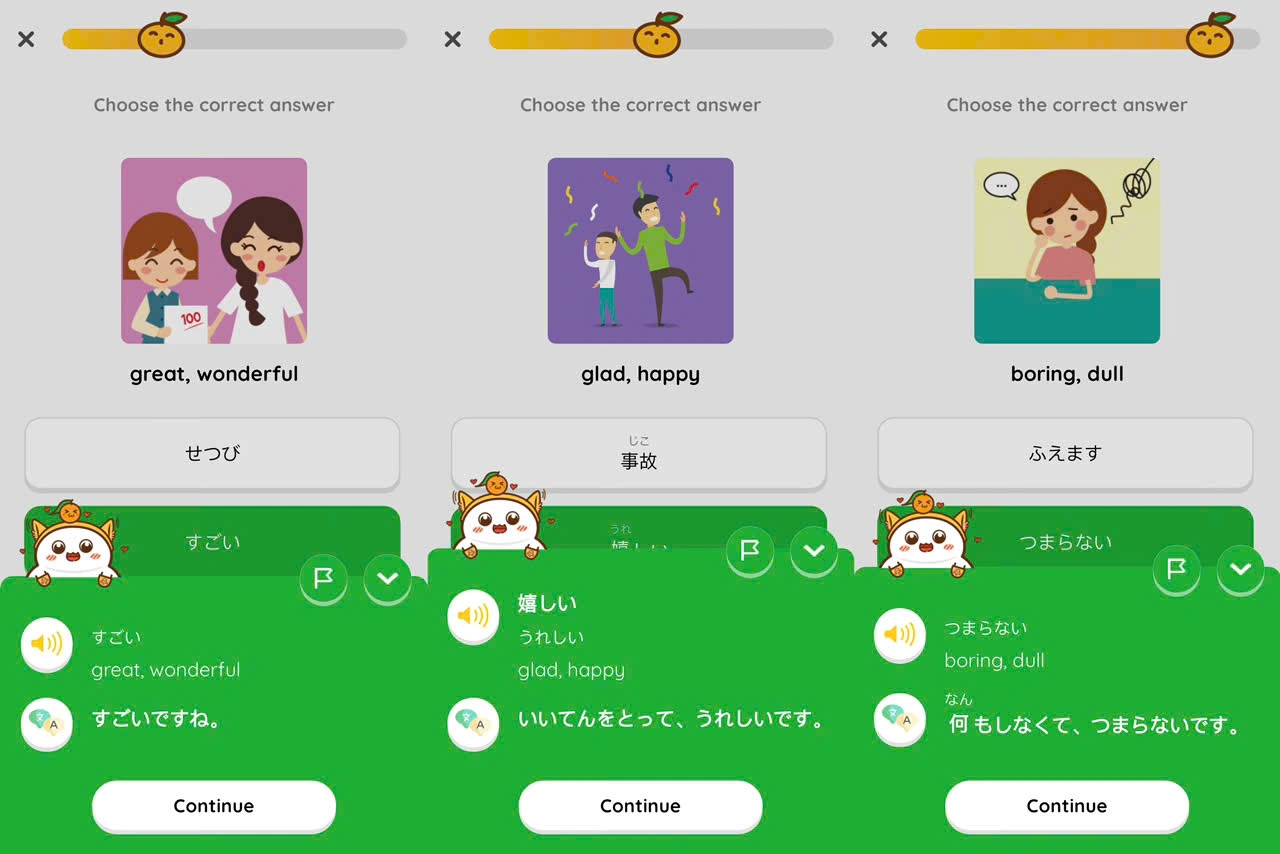
Mastering Japanese adjectives can be challenging, but MochiKanji simplifies the process significantly. This app employs flashcards for effective memorization of both い – adjectives and な – adjectives, ensuring you retain vocabulary over time. With its Golden Time feature, you can optimize your study sessions by focusing on the most relevant words when you’re most alert. Additionally, MochiKanji’s engaging study methods allow you to practice conjugation and usage in an enjoyable, interactive way.
Adjective conjugation table
In Japanese, adjectives can be conjugated to express different meanings, including positive and negative forms, as well as past and present tenses. Conjugation differs between い-adjectives and な-adjectives.
1. Conjugating い-Adjectives (i-Adjectives)
い-adjectives are adjectives that end in 「い」 in their dictionary form. To conjugate い-adjectives, you modify the ending of the adjective based on the tense and polarity (positive or negative) you want to express.
Let’s use the example 楽しい (tanoshii) – “fun.”
| Form | Japanese | Meaning |
| Present Positive | 楽しい (tanoshii) | fun |
| Present Negative | 楽しくない (tanoshikunai) | not fun |
| Past Positive | 楽しかった (tanoshikatta) | was fun |
| Past Negative | 楽しくなかった (tanoshikunakatta) | was not fun |
Examples in sentences:
- Present Positive: 今日は楽しいです。(Kyou wa tanoshii desu.) – Today is fun.
- Present Negative: 今日は楽しくないです。(Kyou wa tanoshikunai desu.) – Today is not fun.
- Past Positive: 昨日は楽しかったです。(Kinou wa tanoshikatta desu.) – Yesterday was fun.
- Past Negative: 昨日は楽しくなかったです。(Kinou wa tanoshikunakatta desu.) – Yesterday was not fun.
General Rule for い-Adjective Conjugation:
- Negative Form: Remove the final 「い」 and add くない.
- Past Positive Form: Remove the final 「い」 and add かった.
- Past Negative Form: Remove the final 「い」 and add くなかった.
2. Conjugating な-Adjectives (na-Adjectives)
な-adjectives do not end in 「い」 and require the particle な when directly modifying a noun. To express different forms, you conjugate the auxiliary です (desu) rather than the adjective itself.
Let’s use the example 静か (shizuka) – “quiet.”
| Form | Japanese | Meaning |
| Present Positive | 静かです (shizuka desu) | quiet |
| Present Negative | 静かじゃないです (shizuka janai desu) | not quite |
| Past Positive | 静かでした (shizuka deshita) | was quiet |
| Past Negative | 静かじゃなかったです (shizuka janakatta desu) | was not quiet |
Examples in Sentences:
- Present Positive: この場所は静かです。(Kono basho wa shizuka desu.) – This place is quiet.
- Present Negative: この場所は静かじゃないです。(Kono basho wa shizuka janai desu.) – This place is not quiet.
- Past Positive: 昨日は静かでした。(Kinou wa shizuka deshita.) – Yesterday was quiet.
- Past Negative: 昨日は静かじゃなかったです。(Kinou wa shizuka janakatta desu.) – Yesterday was not quiet.
General Rule for な-Adjective Conjugation:
- Negative Form: Add じゃないです after the adjective.
- Past Positive Form: Add でした after the adjective.
- Past Negative Form: Add じゃなかったです after the adjective.
Conclusion
Mastering adjectives in Japanese can open up a whole new world of expression, allowing you to add color and detail to your sentences. Whether you’re describing a sunny day or your favorite food, understanding い-adjectives and な-adjectives is essential. Start with the basics, practice regularly, and soon, using adjectives in Japanese will feel as natural as using them in English.
Happy learning, and may your Japanese studies continue to be 楽しい (tanoshii) – fun!

